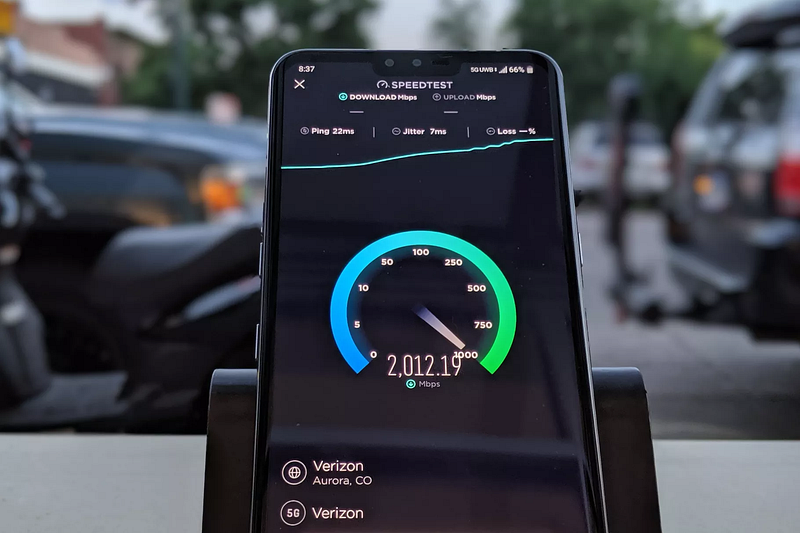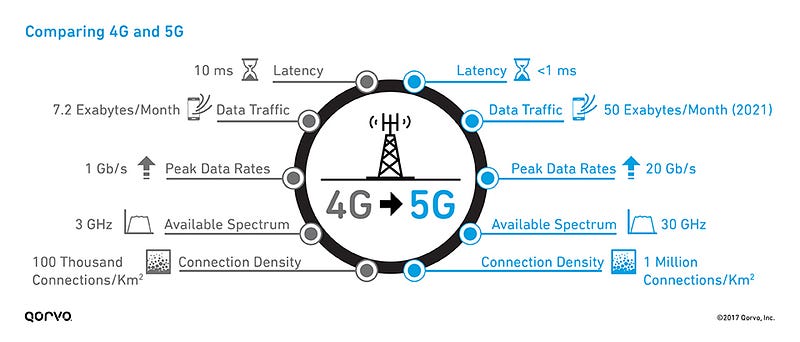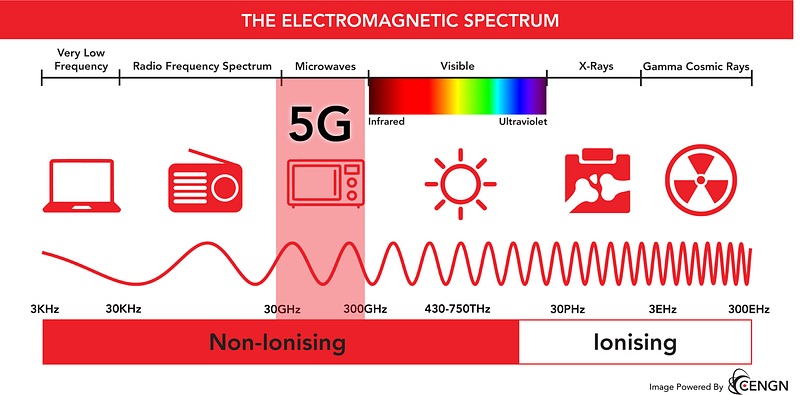What is 5G, and how does it work?
Simply put, 5G is the 5th generation mobile network. It is a new global wireless standard (coming after 1G, 2G, 3G, and 4G). This new standard is designed to connect virtually everyone (and everything) together, from phones to even machines.
5G technology was designed to deliver extremely fast speeds (multi-Gbps peak speeds!), very low latency, more reliability, and a larger network capacity. These features empower user experiences and connect new industries.
Underlying technologies
So what are the underlying technologies that make up 5G? This answer is going to be a bit complicated.
5G is based on Orthogonal frequency-division multiplexing (OFDM), which is a method of reducing interference by modulating a digital signal across various different channels. 5G also uses 5G NR (5G New Radio) air interface, as well as wider bandwidth technologies such as sub-6 GHz and mmWave.
5G OFDM operates using the same mobile networking principles as 4G, but the new 5G NR air interface can further enhance OFDM and deliver a much higher level of scalability and flexibility. This allows greater access to 5G for more people and devices, for a variety of different use cases.
5G allows for wider bandwidths by expanding the use of spectrum resources, from sub-3 GHz, used in 4G, to 100GHz and beyond. It can operate in both the lower bands (sub-6 GHz, for example), in addition to mmWave (24 GHz and up, for example). This is what allows for the extreme capacity, fast throughput, and low latency.

What’s the difference between 4G and 5G?
In order to answer this question and provide additional context, let’s actually look at all of the previous generations: 1G, 2G, 3G, and then 4G.
First Generation — 1G
- Launched in 1979 in Japan
- Brought to the US in 1983 (and Canada in the mid-1980s)
- Delivered analog voice
- No encryption (anyone with a radio scanner could listen in to a call)
- According to Wikipedia, the only remaining 1G network in operation is in Russia.
Second Generation — 2G
- Launched on the Global System for Mobile Communications (GSM) in Finland in 1991
- Introduced digital voice e.g. CDMA (Code Division Multiple Access)
- Introduced encrypted calls
- Introduced text messages (SMS) and multimedia messages (MMS)
Third Generation — 3G
- Launched in 2001 in Japan
- Introduced mobile data (e.g. CDMA2000)
- Introduced international roaming services (due to the standardized protocol)
- Video streaming became possible
- Gave the ability to use the internet, visiting websites, and streaming music
- 2G offered some of these features, however the increased speed of 3G made it much more accessible
Fourth Generation — 4G LTE
- Introduced in Norway near the end of 2009
- Brought to Canada in mid-2011
- Brought the era of mobile broadband
- Providing high-quality video streaming, fast internet access, HD videos, and even online mobile gaming
Logically, following 4G is 5G, which is an improvement on the previous generations of the standard. 5G will impact every industry, making things like safer transportation and even remote healthcare, among other things, a reality.

What improvements are there from 4G to 5G?
There are quite a few differences between the two standards, and many reasons why 5G is superior, for example:
- 5G is quite a bit faster than 4G
- up to 20 Gbps peak data rates
- 100+ Mbps average data rates
- 5G has a larger capacity than 4G
- designed to support a 100x increase in traffic capacity and network efficiency
- 5G has much lower latency than 4G
- allows for more instantaneous, real-time access
- 10x decrease in end-to-end latency, down to 1ms
- 5G is a unified platform that is more capable than 4G
- 4G focused on providing faster services than 3G
- 5G was designed to elevate mobile broadband experiences, and also support new services like mission-critical communications and IoT
- 5G also natively supports all spectrum types and bands, a wide range of deployment models, and new ways to interconnect
- 5G uses spectrum better than 4G
- designed to get the most out of every bit of spectrum, from low bands below 1 GHz, to mid bands from 1 GHz to 6 GHz, to high bands, known as millimetre wave (mmWave)
Economic impact of 5G
5G is driving global economic growth. Through a 5G Economy study, it was found that 5G’s full economic impact will likely be realized globally by 2035, supporting a wide range of industries and even potentially enabling up to $13.2 trillion worth of goods & services.
This impact is much higher than with previous generations. The development requirements of the new 5G network are also expanding beyond the traditional mobile networking players to industries, like the automotive industry.
This same study also revealed that the 5G value chain (including OEMs, operators, content creators, app developers, and consumers) could support up to 22.8 million jobs.
There are other potential impacts 5G could have on the economy, but only time will tell what the full effect will be.
The Controversy & Conspiracy Theories
I’m sure you’ve seen people doubting the safety of 5G online. There are plenty of conspiracy theories involving 5G, and of course, completely disregarding the science.
One example of a conspiracy theory involving 5G is the claim that 5G is a hazard to your health. This claim dates back to the 1920s, when mobile phone usage was incredibly limited, with critics claiming the 2G airwaves could cause cancer.
Although the vast majority of the world rejects these rumours, the emergence of 5G seems to have caused a rebirth of these claims. Numerous public health authorities, like the World Health Organization (WHO), and the International Commission on Non-Ionizing Radiation Protection (ICNIRP), which is the Germany-based scientific body in charge of setting limits on exposure to radiation, have both stated on numerous occasions the airwaves used by mobile communications is not harmful to health.
In order to determine whether these higher-frequency waves are harmful to our health or not, let’s take a look at the electromagnetic spectrum.

What makes radio frequencies harmful?
As you can see at the bottom of the chart, there are two types of radiation listed: non-ionizing and ionizing. Ionizing radiation is what makes some radio frequencies more dangerous. When ionized atoms come into contact with living tissue, it causes the cells to be ripped apart, causing things like radiation burns, damage to cells, sickness, cancer, and in some cases, even death.
However, there is absolutely no reason to worry, 5G is very safely inside the non-ionizing range. Although 5G waves can extend up to 300 GHz, only waves up to 100 GHz are used for 5G deployments.
Let’s take another look at the electromagnetic spectrum, this time with the 5G range highlighted:

As you can see, the waves created by 5G are very safely within the non-ionizing range. In fact, these frequencies are between about 2,500 to 14,000 times less potent than the power we receive from the sun. If anything, we should be a lot more afraid of the sun and its UV rays causing health problems than this.
5G and COVID-19
One of the more ridiculous claims is that 5G is the cause of COVID-19. In March, Dr. Thomas Cowan, a US doctor who is now on disciplinary probation, claimed that 5G poisoned cells in the body, forcing them to excrete waste, which eventually became known as COVID-19. The video went viral, being reposted by multiple celebrities, but has been disproven by several scientists who questioned the validity of the evidence Cowan presented. The video has also since been removed from YouTube.
“Viruses are not just debris,” Jason Kindrachuk, a virologist and Canada research chair in emerging viruses at the University of Manitoba, said in an interview with CBC. “Viruses don’t just get created as a way to deal with poison.”
Scientists have been able to recreate the virus in a lab, proving it is not simply a secretion from human cells. Cowan made several other outlandish claims in the video, suggesting the emergence of the Spanish Flu (in 1918) coincided with the launch of commercial radio services (in 1920), and also claiming the fact Wuhan is ground-zero for COVID-19 and the first city to have 5G (which it was not, Shanghai was the first city with coverage).
People are burning down cell towers
These conspiracy theories have lead to people burning down many cell towers. In this CNET article from May 2020, 77 cell towers were burned down in the UK alone, and states that as of April 21, 2020, 40 employees of one UK carrier were attacked physically or verbally, with one even being stabbed and hospitalized as a result of the attack.
The issue is not restricted to the UK, with towers being burned down in other places as well, including in Quebec, Canada, the Netherlands, and the US.
In the US, one woman even shot at cellphone tower workers (while they were up in the tower, working), and barricaded herself in her home with two axes, before being arrested by police.
Funnily enough, 5G towers apparently look quite similar to towers carrying crucial 4G and 3G services, and very few of the attacked towers were actually correctly identified. This, however, resulted in outages in service for thousands of people, and also crippled the coverage for emergency services, while the damage to the towers was fixed.

My thoughts on 5G
This is something that interests me quite a bit. I’m looking forward to seeing 5G in my local area in the future (hopefully soon!), and to see the innovations enabled by this new technology around the world. This new standard looks very exciting, and I’m thrilled to see where it will go.
The reality of today’s existing 5G networks is that nearly all of them are still in their infancy. It’s hard to predict where the world will go, and what we will be able to do with this, but from what we know now, it looks very promising.